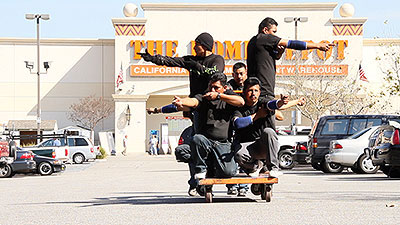
Continuing through January 15, 2012
Curatorial intention is key in exhibitions on a theme that present a wide array of artists. The question for “Agitated Histories” curators, who present 15 “international and intergenerational” artists in this show, is just how agitated is the viewer supposed to become? And for what reasons? “Agitated Histories” conveys the oddly paired impressions that it’s a well-conceived exhibition, but one that’s difficult to connect with personally: a “yes, but” kind of thing. Much of the work is quite strong, as is the opening piece in the lobby, a video by Mark Tribe of a re-enactment of civil-rights activist César Chavez speaking out against the war in Vietnam. Originally aired on the huge screen at Times Square in New York, the video is silent, with captions running along the bottom of the projection. Experiencing the artist discuss this work and his two other videos (featuring speeches by Stokely Carmichael and Angela Davis), viewers will conclude that Tribe’s work is inarguably compelling. It speaks well to the exhibition’s theme of questioning or reconstructing historical orthodoxies.
On entering the exhibition, this reviewer felt agitation, all right, but of the ADHD type. I found it difficult to actually inhabit the galleries long enough to adequately take in the art. The space was definitely not overhung, but there were so many narratives going on throughout the show that it felt as if I was surrounded by a gang of storytellers, each urgently intent upon getting my attention. Some spoke softly yet persistently, like Daniel Joseph Martinez in “Divine Violence,” a play on Sol LeWitt’s modular art with an underlying discourse on politically generated violence. Ensconced in its own gallery, each of Martinez’s gridded gold-flaked panels — they could have been cut out of car doors — named an organization that uses violence as a means to its end. Seeing “Greenpeace” next to “Al Qaeda,” for example, poses an ethical dissonance, but it's so obvious as to be heavy handed. The work ends up as the conceptual opposite of LeWitt. Martinez’s works function best when viewed from just outside the gallery space they inhabit, where they remain subtly alluring. Once inside the gallery, they convey an overly simplified didacticism.
Perhaps this is a palimpsest of the whole: Many of the works look great on first glance, then cave in with the weight of their own content. Exceptions were Geof Oppenheimer’s “Anthem,” exposing as it does the homoeroticism of the military. Although I’m not sure that was the artist’s intended subtext, it adds layers of meaning to the video of an army band playing a jazzed-up mix of various patriotic marching songs. Lorraine O’Grady’s four large-scale photographs position, in diptych format, Charles Baudelaire and Michael Jackson as “The First and Last of the Modernists.” While the title could be argued up one theoretical side and down the other, the compositions are frankly lovely, even loving. Does “Agitated Histories” encourage change, or is it merely a string of storylines airing at the same time at full volume? If the latter is the case, I’ll take mine one episode at a time, please, so that I can focus on the content.
